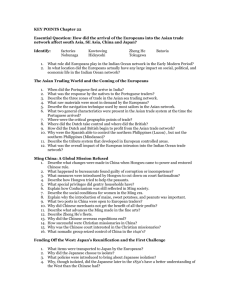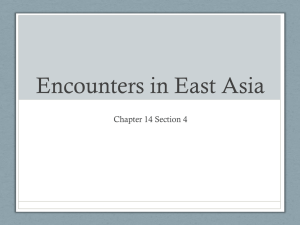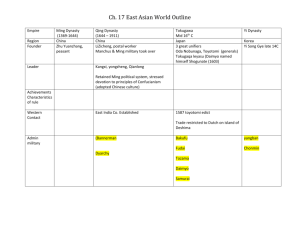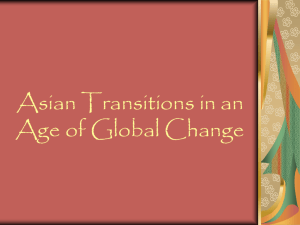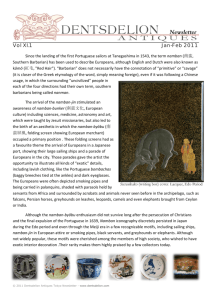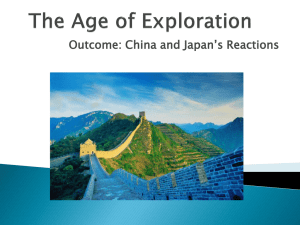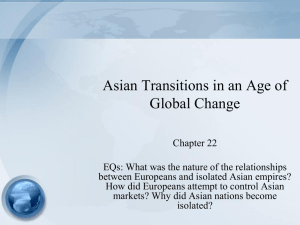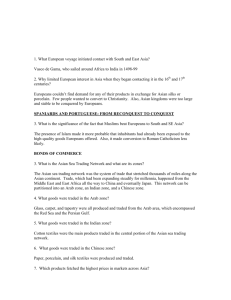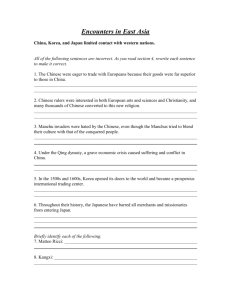B. Ming China: A Global Mission Refused
advertisement
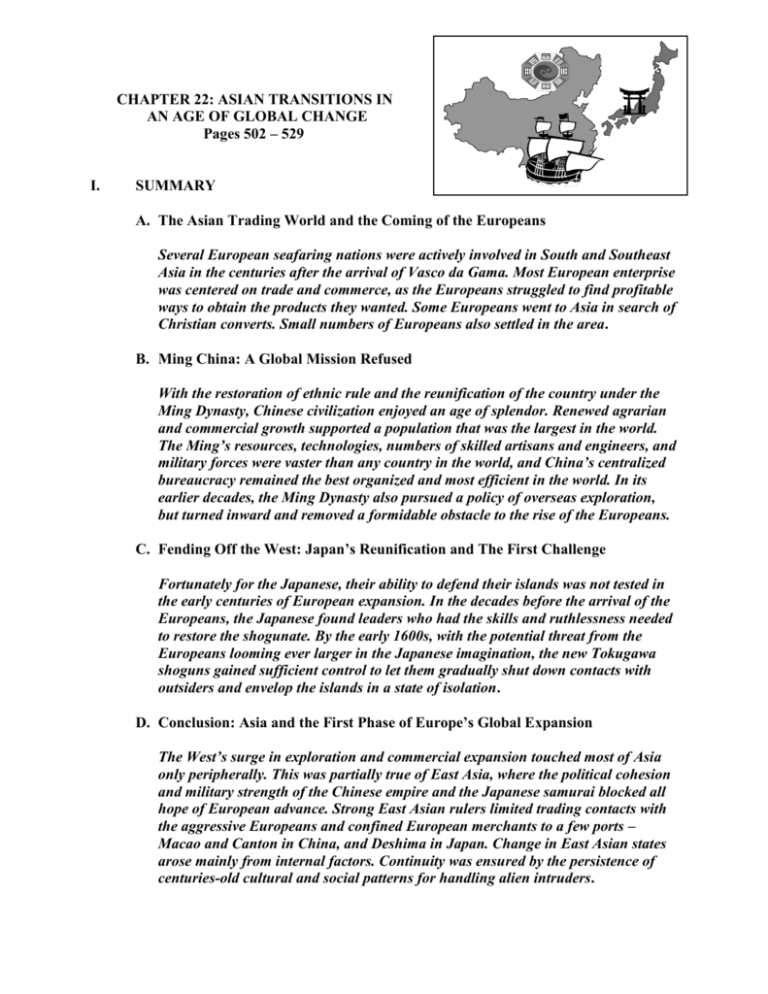
CHAPTER 22: ASIAN TRANSITIONS IN AN AGE OF GLOBAL CHANGE Pages 502 – 529 I. SUMMARY A. The Asian Trading World and the Coming of the Europeans Several European seafaring nations were actively involved in South and Southeast Asia in the centuries after the arrival of Vasco da Gama. Most European enterprise was centered on trade and commerce, as the Europeans struggled to find profitable ways to obtain the products they wanted. Some Europeans went to Asia in search of Christian converts. Small numbers of Europeans also settled in the area. B. Ming China: A Global Mission Refused With the restoration of ethnic rule and the reunification of the country under the Ming Dynasty, Chinese civilization enjoyed an age of splendor. Renewed agrarian and commercial growth supported a population that was the largest in the world. The Ming’s resources, technologies, numbers of skilled artisans and engineers, and military forces were vaster than any country in the world, and China’s centralized bureaucracy remained the best organized and most efficient in the world. In its earlier decades, the Ming Dynasty also pursued a policy of overseas exploration, but turned inward and removed a formidable obstacle to the rise of the Europeans. C. Fending Off the West: Japan’s Reunification and The First Challenge Fortunately for the Japanese, their ability to defend their islands was not tested in the early centuries of European expansion. In the decades before the arrival of the Europeans, the Japanese found leaders who had the skills and ruthlessness needed to restore the shogunate. By the early 1600s, with the potential threat from the Europeans looming ever larger in the Japanese imagination, the new Tokugawa shoguns gained sufficient control to let them gradually shut down contacts with outsiders and envelop the islands in a state of isolation. D. Conclusion: Asia and the First Phase of Europe’s Global Expansion The West’s surge in exploration and commercial expansion touched most of Asia only peripherally. This was partially true of East Asia, where the political cohesion and military strength of the Chinese empire and the Japanese samurai blocked all hope of European advance. Strong East Asian rulers limited trading contacts with the aggressive Europeans and confined European merchants to a few ports – Macao and Canton in China, and Deshima in Japan. Change in East Asian states arose mainly from internal factors. Continuity was ensured by the persistence of centuries-old cultural and social patterns for handling alien intruders. II. CHAPTER REVIEW A. How did the arrival of the Europeans affect the Asian trading network? B. Describe the Asian sea-trading network? C. How did the Europeans establish and maintain their trading empires in Asia? D. Who challenged the Portuguese in Asia and with what results? E. What was the relationship between trade and religion for Europeans in Asia? F. How did the Ming Dynasty attempt to reform and govern its empire? G. Describe the Ming social hierarchy. H. What evidence is there that the early Ming rule was a revived Golden Age? I. What were the motives for the Ming naval expeditions? Why were they ended? J. What led to the decline of the Ming? K. How did the Japanese deal with the European challenge? III. VOCABULARY A. Caravel B. Asian sea trading network C. Mercantilism D. Ormuz, Goa, Malacca E. Factories F. Dutch trading empire G. Treaty of Gijanti H. Philippine Islands I. Jesuits in Asia J. Friars K. Ming Dynasty L. Macao, Canton, Deshima M. Tokugawa Shoguns N. School of National Learning IV. MAP EXERCISES A. Map 22.1: Routes and Products in the Asian Trading Network, c. 1500 (Page 506) 1. Reading the Map a. Identify the three zones? b. What elements of geography define the zones? (see maps at back of book) c. What are choke points? d. What are the major ports and where are they located? e. What religion (see page 158) controlled the Indian Ocean zone? f. What products are traded within the zones? 2. Interpreting a Map a. To control the trade on the map, what would you need to do? b. Which zone would trade with both zones? Why? B. Map 22.2: Ming China and the Zheng He Expeditions, 1405 – 1423 (Page 530) Compare Maps 22.1 and 22.2. What conclusions do you reach? Why? V. PHOTO ESSAY: The Coming of the Europeans A. How did the Asians perceive the European (Pages 502-503, 509, and 526): 1. Ships? 2. Religions? 3. Merchants and trade goods? B. Describe Portuguese and European 1. Naval technology (Page 508). 2. Missionaries (Page 522). C. Describe the worlds and perceptions of 1. Ming Concubines (Pages 518 – 519). 2. Scholar bureaucrats (Page 516). 3. Japanese shogun (Page 525). VI. VISUALIZING THE PAST: Intruders (Pages 510 – 511; compare to page 506) A. Europe in Asia 1. Name the ports of each European nation. a. Portuguese b. Spain c. Dutch d. English 2. Where did the Europeans locate their imperial capitals? 3. What regions did each power attempt to control? a. Portuguese b. Spain c. Dutch d. English B. Drawing Conclusions 1. Which European state had the strongest position in Asia? Why? 2. What nation had the least stake in Asia? Why would this be unimportant? 3. How did Europe redirect the flow of trade routes? 4. What areas seem least affected by the European presence? Why? VII. DOCUMENT ANALYSIS: Chinese Examination System (Page 515) A. Document Analysis 1. Who wrote the document? (Attribution includes biographical references) 2. What is the author’s point of view? 3. How reliable is the document? Why? 4. What was the intent or purpose behind the document? 5. Who was the intended audience? 6. What is the document’s tone? B. Conclusions 1. From the exam questions, what can we learn about Chinese society? 2. Where do the Chinese look for models to orient their social behavior? 3. What types of skills and knowledge do the Chinese value? 4. What are the advantages and disadvantages to the exam system? VIII. MULTIPLE CHOICE QUESTIONS 1. When the Portuguese arrived in India in 1498, they A. found they had little to offer in trade but could get rich by using force. B. quickly integrated themselves into the Asian trade system. C. exchanged their European goods for Asian luxury items. D. were unwelcome. E. established cordial relations with the Muslim merchants. 2. The periphery of the Indian Ocean trading network around 1500 C.E., specifically Africa, Southeast Asia, and Japan furnished what items to the network? A. slaves B. cotton textiles C. carpets and tapestries D. porcelain and silks E. mainly raw materials 3. The highest prices in the Asian network were paid for A. cotton textiles. B. spices. C. bulk items such as foodstuffs. D. silk and porcelains. E. gold and silver. 4. Long distance travel and trade in the Asian trade zone was based on A. foodstuffs transported to feed the population of India. B. Muslim pilgrimages to and from Mecca. C. tribute from client states to the Chinese Empire. D. products with the highest profit margins, which were easily transported. E. transport of slaves. 5. The largest portion of Asian trade by volume in the Early Modern Era was the trade in A. silk from China to the Middle East. B. cottons from India to the Middle East. C. bulk items, usually foodstuffs, exchanged within each of the main zones. D. spices from the East Indies. E. slaves from Africa. 6. The Portuguese were able to control trade in Asian waters because A. they had endless supplies of gold and silver to buy goods. B. states in the area granted Portuguese merchants a trade monopoly. C. they had superior weapons and controlled trade through force. D. the Chinese had withdrawn from trade in Asia. E. the Portuguese captains allied with the Mughals, who controlled the area. 7. Rather than try to control trade in the Indian Ocean as had Portugal, the Dutch A. attempted to monopolize the spice trade from the East Indies. B. cooperated with the Muslim and Hindu merchants. C. signed trading agreements with local rulers. D. abided by the traditional trading practices of the region. E. concentrated on trade in India. 8. The Dutch and Portuguese empires in Asia relied on all of these EXCEPT: A. fortified towns and bases. B. factories. C. migration of thousands of Europeans to settle in Asia. D. warships on patrol. E. monopoly control of a limited number of products. 9. Europeans learned that the greatest trading profits in Asia could be made by A. allying with the Hindus and warring on the Muslim states. B. transporting other peoples’ goods and providing services as middlemen. C. seizing lands and creating land-based empires. D. peaceful cooperation with and integration into existing Asian trade networks. E. “turning” pirate and raiding other nations’ merchant ships. 10. In Asia, European naval technologies and trade practices had little effect against A. Ceylon and Java. B. Asian states with strong militaries and determined rulers. C. the Philippine Islands. D. the coasts and peoples of East Asia. E. the islands of the East Indies. 11. Europeans learned that the most successful missionary work in Asia occurred by A. having missionaries use local languages and become acclimated to cultures. B. forcibly converting the Muslims and Hindus to Christianity. C. converting the poorest and lowest social classes first. D. converting the elites first; the other classes would follow. E. converting areas, that had never previously been converted by Muslims. 12. Following the defeat and expulsion of the Mongols from China, A. a legalist regime was established. B. the Ming Dynasty arose. C. peasants were granted equality with the scholar-gentry and noble classes. D. China converted to Buddhism. E. the civil service exam system of the Mongols was ended. 13. The first Ming emperors of China attempted to end all of these abuses EXCEPT: A. abolishing the position of chief minister, who had too much power. B. dishonesty, disloyalty, and laziness. C. court factions and conspiracies. D. the influence of the Emperor’s wives and their relatives. E. the influence of the scholar-gentry. 14. During the Ming Dynasty, the true power of China resided with A. prosperous peasants. B. merchants in port cities who administer foreign trade missions. C. the eunuch bureaucrats in the capital city. D. rural landlord families with relatives in the imperial bureaucracy. E. aristocrats and nobles. 15. The Ming abandoned the naval expeditions for all these reasons EXCEPT: A. the Portuguese defeated the Chinese navies on the last voyage. B. the money spent on the voyages had little return. C. Northern steppe nomads were a greater threat than pirates and sea peoples. D. court rivals of Zheng He opposed the voyages. E. the last emperors were unenthusiastic about the voyages. 16. When the Europeans reached Japan, the Japanese A. were united and strong under an absolute emperor. B. were engaged in a cycle of civil wars. C. welcomed Christian missionaries and merchants. D. refused to admit foreigners to their nation. E. population was devastated by diseases. 17. The Japanese dealt with the long-term European challenge by A. allying with the Portuguese against the other Europeans. B. permitting the Jesuits to convert the Japanese to Christianity. C. permitting the Europeans to establish a trading monopoly in Japan. D. self-imposed isolation and forbidding most European contacts. E. adapting European customs and technology. IX. ESSAY QUESTIONS A. Compare and contrast Japanese and Chinese reactions to the European arrival. B. Compare and contrast Portuguese and Chinese maritime expeditions in Asia. C. Compare and contrast the Indian Ocean trading network before and after the arrival of the Europeans. (Change over time) D. Compare and contrast the spread of Christianity in Asia with the spread of Hinduism or Islam throughout Asia. E. Compare and contrast the Indian Ocean trading network with the Iberian empires in the Americas.
